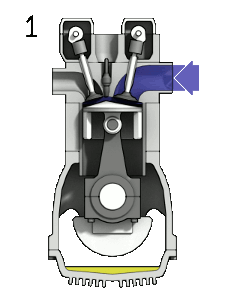Other Engines
Instead of a Carnot engine, gasoline-fueled cars use what is called the Otto cycle, invented by Nicolaus Otto in 1876. Like the Carnot cycle, it involves four steps, but instead of an atmospheric gas it uses an air-gasoline mixture. This mixture exists in a chamber (called a "cylinder") whose size increases and decreases due to the motion of a piston, as seen here.
- During the intake phase, the piston lowers and a valve opens, allowing an air-gasoline mixture to enter the cylinder.
- During the compression phase, the piston compresses the air-gasoline mixture, with both valves closed.
- During the combustion or power phase, a spark plug ignites the gasoline. The heated air forces the piston back down, doing positive work $W_{out}$ on the piston which is then used to move the automobile, charge the battery, etc.
- During the exhaust phase, the used-up gasoline mixture is pushed out of another valve, readying the cylinder for the next round.
There are normally multiple cylinders which operate out of phase with each other: that is, while one is in the intake phase, another is in compression, another is in combustion, and so forth. Part of the work done by the combustion phase in a cylinder is to move the pistons (by means of a turning wheel called a crankshaft) of the other cylinders in their other phases.
One weakness of the Otto cycle is that it relies on the timing of spark plugs: if the gas is ignited too soon or too late in the cycle, the operation is not as efficient as it should be. Another problem is that the gasoline must not be allowed to get too hot during the compression phase, or else it will pre-ignite before the spark occurs, with the same problem. Diesel engines avoid both these problems: it compresses its fuel much more than in the Otto cycle until the fuel ignites on its own, without a spark plug. Diesel fuel burns at much higher temperatures than gasoline, and as we discussed in Heat Engines, a hotter reservoir results in higher efficiency.